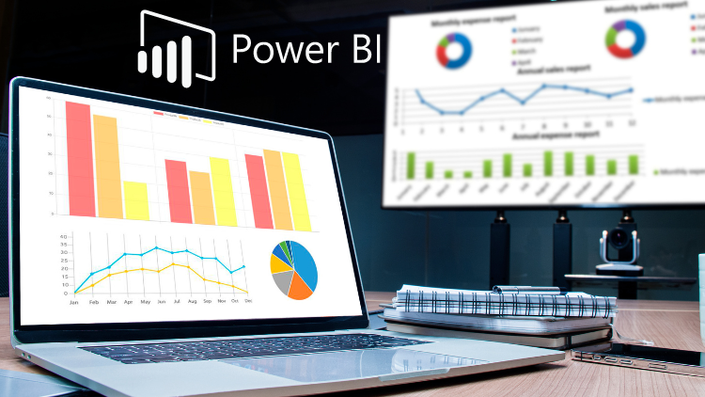
Power BI Step by Step Tutorial for Beginners & Experienced
Part 1 - What is Power BI, Linked Reports, Power BI Installation, Power Query,
- Chapter 1:- What is Business Intelligence, Power BI and Why Power BI ?
- Chapter 2:- How to Download and Install Power BI
- Chapter 3:- Interface Tour of Power BI Desktop
- Chapter 4:- Connecting to Text/CSV Source File
- Chapter 5:- Power Query Editor : Shaping up CSV Data, Working with Applied Steps, Renaming Data Table, Headers and Removing Blank Rows, Error Data, Replacing Values.
- Chapter 6:- Loading Multiple Data : Excel Data with CSV Data
- Chapter 7:- Creating Duplicating Columns For Creating Relationship in Data Model.
- Chapter 8:- Loading and Formatting Data in Stacked Bar Visual, Creating & Duplicating Pages
- Chapter 9:- Working with Clustered Bar Chart, Pie Chart, Line Chart and Funnel Chart
- Chapter 10:- Working with Slicers, Table, Donut Charts, Maps, Cards
- Chapter 11 :- Understand types of filters, Data Filters, TopN, types of filters in power bi?
- Chapter 12 :- Conditional Formatting in Charts
- Chapter 13 :- Linked Reports (Drill Through Report)
- Chapter 14 :- Working with Bookmarks and Buttons
- Chapter 15 :- Exploring Data with QnA Component
- Chapter 16 :- Connecting SQL Server Database and creating visual
- Chapter 17 :- Connecting Website URL and Creating Visuals
- Chapter 18 :- What is Power Query ?
- Chapter 19 :- Understanding Data Types and Creating Custom Tables
- Chapter 20 :- Keep rows and remove rows
- Chapter 21 :- Removing Special Characters (Rupee Symbol) From Strings (M-Function)
- Chapter 22 :- Basic Calculations (Standard and Scientific), Conditional Columns and Creating Index
Part 2 - Explain Pivot vs Unpivot, Parameters, Merge and append Queries .
- Chapter 23 :- Pivot and Unpivot
- Chapter 24 :- Working with Parameters (Simple, List, Query)
- Chapter 25 :- Merge Queries and Append Queries.
Part 3 - Joins and Join Kind, Optimize PBIX File , Database Normalization.
- Chapter 26 :- Types of Join or Types of Join Kind in Power BI.
- Chapter 27 :- How to optimize PBIX file using Load Feature.
- Chapter 28 :- Understand Database Normalization.
Part 4 - Explain Data Model, OLTP, Star Schema & Snowflake Design. Dax Function
- Chapter 29 :- What is Data Model, Fact Table, Dimension Table?
- Chapter 30 :- OLTP VS OLAP, Star Schema and SnowFlake designs.
- Chapter 31 :- Explain DAX and how to Create Measure Table.
- Chapter 32 :- Calculated Columns vs Calculated Measures.
- Chapter 33 :- Dax Function - SUM vs SUMX.
Part 5 : Maths DAX Function, Logical DAX Function, Text DAX Function in Power BI.
- Chapter 34 :- Maths DAX Functions : MIN, MAX, AVERAGE, DISTINCT, COUNT
- Chapter 35 :- Logical DAX Functions : IF, AND, OR, TRUE, FALSE, ISTEXT, ISERROR, ISBLANK, SWITCH.
- Chapter 36 :- Text DAX Functions : TRIM, LEN, LOWER, UPPER.
Get enrollment to the course - https://www.questpond.com/ordernow.php
Course Curriculum
First Section
Available in
days
days
after you enroll
-
PreviewPart 1 - What is Power BI, Linked Reports, Power BI Installation, Power Query. (114:19)
-
StartPart 2 - Explain Pivot vs Unpivot, Parameters, Merge and append Queries. (34:56)
-
StartPart 3 - Joins and Join Kind, Optimize PBIX File , Database Normalization. (34:49)
-
StartPart 4 - Explain Data Model, OLTP, Star Schema & Snowflake Design. Dax Function. (39:19)
-
StartPart 5 : Maths DAX Function, Logical DAX Function, Text DAX Function in Power BI. (51:26)
-
StartPart 6 :- Understand Filter Dax Functions in Power BI. (35:57)
-
StartPart 7 :- Explain ALL, ALLExcept, AllSelected Table Joins-Crossjoin, Union. (29:38)
-
StartPart 8 :- Explain Fields in Power BI, Numeric range parameter and difference between DateAdd and ParallelPeriod. (37:01)
-
StartPart 9 :- LookupValue DAX Function and Date & Time Function in Power BI. (29:54)
-
StartPart 10 :- DAX Variables, Power DAX USERELATIONSHIP & TREATAS. (27:30)
-
StartPart 11 :- Explain the difference between TotalMTD & DatesMTD, what is SAMEPERIODLASTYEAR function in DAX. (31:52)
-
StartPart 12 :- What is RELATED and RELATEDTABLE, Calculate Top N Values Dynamically & rank using DAX RANKX. (35:42)
-
StartPart 13 :- Explain SELECTEDVALUE DAX function, SELECTCOLUMNS vs ADDCOLUMNS. (32:38)
-
StartPart 14 :- Use GROUPBY without DAX, Explain SUMMARIZE vs GROUPBY. (29:51)
